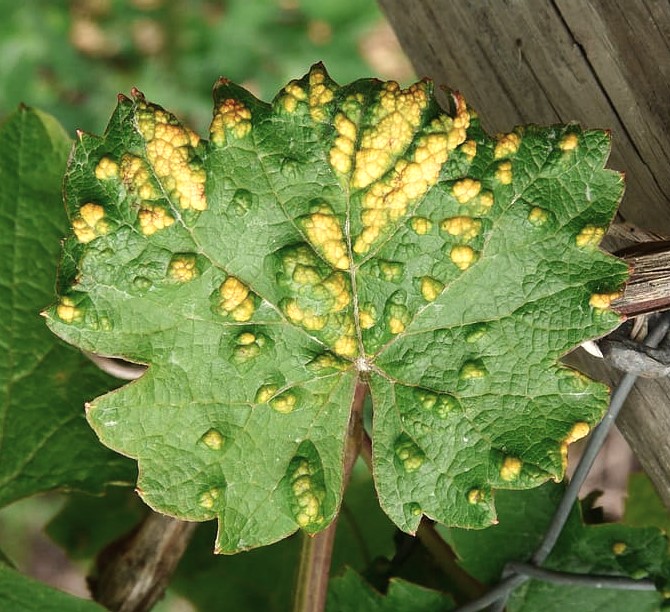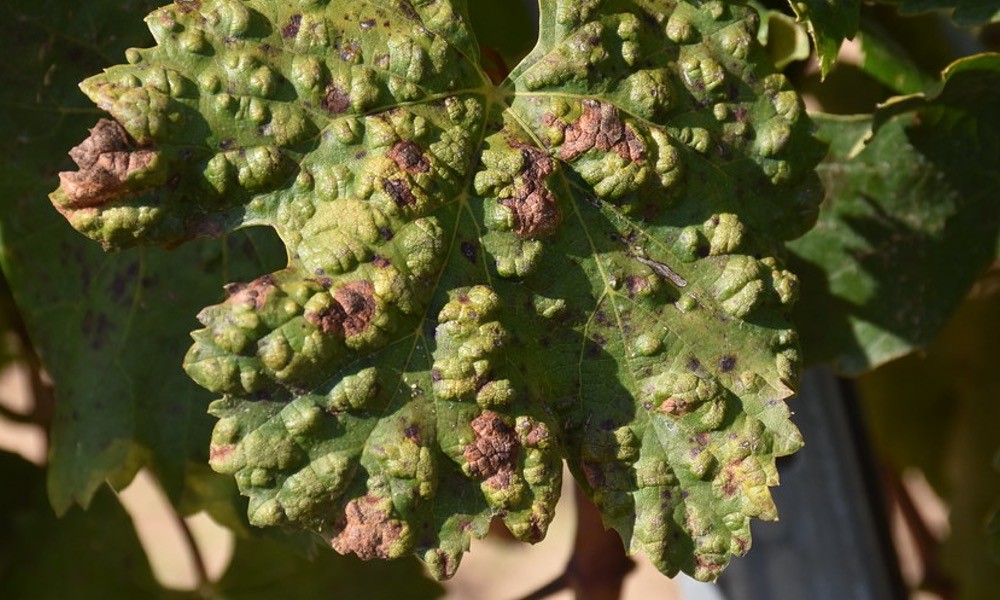
Erinosis
Colomerus Vitis (Eriophyes Vitis)
Pathogène :
Insect
Type:
Risque:
INTERMEDIATE
Ácaros



QUI EN EST LA CAUSE ?
Colomerus vitis (previously known as Eriophyes vitis) is a microscopic mite that belongs to the family Eriophyidae, and is one of the most harmful pests of grapevines. This mite is elongated in shape, with two pairs of legs located on the front of its body, and its size is so small that it is difficult to detect it with the naked eye. During the winter, the adult mites take refuge under the scales of the vine buds, where they remain inactive until temperatures begin to rise in spring. At this point, they emerge and begin feeding on the young shoots of the plant. The females lay their eggs on the underside of the leaves, and in a few days the larvae hatch, also beginning to feed on the vine tissues. Colomerus vitis goes through several generations a year, being especially active in the phases of greatest growth of the vine. Its reproductive cycle is rapid, which favors the proliferation of this pest during the warm months, generating large populations in a short time.
SYMPTÔMES
Erinosis is the disease caused by Colomerus vitis in the vine, and is characterized by the appearance of galls and deformations on the leaves and other plant tissues. These mites feed on cellular content, injecting substances that cause a hypertrophied reaction in the vine tissues. This interferes with photosynthesis and respiration of the plant, which can considerably reduce its vigor and, consequently, the quality and quantity of production.
- Formation of galls or bumps on the underside of the leaves.
- Leaves with a rough and deformed appearance.
- Presence of a cottony layer on the gills, produced by the mite.
- Loss of vigor in the plant and less growth of the shoots.
- Decrease in the production of clusters due to the affectation of leaves and young shoots.
- In severe cases, premature defoliation and weakening of the plant.
TEMPÉRATURE ET HUMIDITÉ
18-28°C
60-80%
VOIES DE TRANSMISSION
Wind, Contaminated plant material, Agricultural tools, Direct contact between plants
TRAITEMENTS
Traitements chimiques
• SULFUR 80% [SC] P/V
• SULFUR 80% [WP] P/P
• SULFUR 80% [WG] P/P
• SULFUR 99% [DP] P/P
• SULFUR 70% [SC] P/V
• SULFUR 72% [SC] P/V
• ORANGE OIL 60g/L [ME] P/S
• SULFUR 82.5% [SC] P/V
• PARAFFIN OIL (CAS [97862-82-3]) 80% [EC] P/V
Traitements autorisés en agriculture biologique
• SULFUR 80% [SC] P/V
• SULFUR 80% [WP] P/P
• SULFUR 80% [WG] P/P
• SULFUR 99% [DP] P/P
• SULFUR 70% [SC] P/V
• SULFUR 72% [SC] P/V
• ORANGE OIL 60g/L [ME] P/S
• SULFUR 82.5% [SC] P/V
• PARAFFIN OIL (CAS [97862-82-3]) 80% [EC] P/V
Traitements biologiques
• CHRYSOPERLA CARNEA
Recommandations
- Carry out sanitary pruning during the winter to eliminate affected buds where the mites spend the winter, thus reducing populations in the spring.
- Apply preventive treatments with mineral oils or sulfur at the beginning of sprouting, which act on the mites before they cause significant damage to the sprouts.
- Encourage the presence of natural predators, such as phytoseiid mites, which can help keep Colomerus vitis populations under control.
- Avoid excessive use of broad-spectrum pesticides, as they can eliminate the natural enemies of mites and promote their proliferation.
- Maintain constant surveillance of the first signs of erinosis in young leaves, to intervene early and avoid the massive spread of the pest.
- Implement integrated management practices, combining cultural, biological and chemical measures to reduce pest pressure and avoid dependence on chemical products.
- Use specific acaricides at the appropriate times in the vine cycle, such as sprouting, when mites become more vulnerable to treatment.
TRAITEMENTS
Remèdes maison
There are no home treatments
Alliés naturels
Traitements chimiques
There are no treatments for this disease. Treatments are directed at the insect vectors that transmit it. See insect treatments.
RECOMMANDATIONS
- Check the back of the leaves frequently, especially in dry weather.
- Spray water on the leaves to increase humidity and prevent them from settling.
- Keep plants healthy with good watering and adequate light.
- If you see cobwebs or damage, clean the leaves with a damp cloth or pressurized water.
- Use potassium soap or neem oil every few days until they disappear.
Plantes répulsives
Rosemary, Dill, Coriander
PRODUITS RECOMMANDÉS
*Les traitements recommandés sont des recommandations basées sur les bases de données des autorités et ne remplacent en aucun cas les lignes directrices établies par la législation de chaque pays.
*Les produits présentés sont des recommandations et ne sont pas nos propres produits. En tant qu'associés Amazon, nous gagnons des revenus grâce aux achats de produits recommandés.





















